Jagged Alliance franchise has a lot in common with X-com. Both games combined genres of turn-based tactics, management strategy, and RPG elements. Both are considered cult classics and have a dedicated community to this day. And, sadly, both weren’t exactly successful with sequels. UFO defenders at least got some interesting experiments. And recent XCOM, even with all the liberties developers took, became a popular game on its own.
But JA2 wasn’t so lucky. One or two unrelated projects with devs taking inspiration from Sir-Tech aside, all the later games were either inferior messes or outright cash grabs. Why? What was it so hard to replicate?
The Old Story
The story of Jagged Alliance 2 begins with the former king of Arulco, Enrico Chivaldori hiring you (main character, a leader of mercenary company) to free his island nation from the tyranny of his ex-wife Queen Deidranna. Some divorce…
The intro itself is rather short but after that, you won’t go to Arulco just yet. First, you’ll need to assemble your team and even choose if you want to go on this long and dangerous mission personally.
Both tasks are performed through the “90-s laptop” interface. To hire mercenaries you go to the Association of International Mercenaries (AIM) website and for yourself, you must undertake the Institute of Mercenary Profiling (IMP) test that will effectively create the custom character who has additional traits depending on answers about your personality.

You’ll use the laptop quite a lot through the rest of the game. Not only for hiring additional mercs but also tracking your funds and quests, getting some news through e-mail, and even ordering weapons from the mainland through the arms dealer website.
After the laptop, you will go to the “strategic layer” with the Arulco map divided into squares, each representing a separate tactical location or “sector”. While tactical battles will be your primary concern, each sector can also have local NPCs who provide you with resources, give quests, or simply indulge in a conversation if you talk to them.
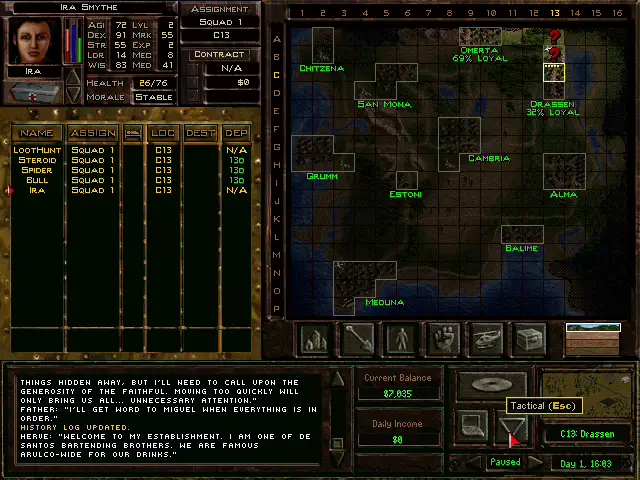
Additionally, Arulco has several settlements spread across the island. Each town takes up several sectors (Meduna, the capital is the largest – six) and has a “loyalty” parameter, depending on how well you’ve taken out Deidranna forces there and fared local NPC requests. High loyalty allows training local militia that you can use as cannon fodd… I mean AI-controlled units in defense battles.
Tactical Combat
In JA2 combat has a lot of nuances. For example, in addition to turns (yours, enemys’, civilian population’s) mercs can “interrupt” enemy action that happens in their line of sight. If that happens, that particular merc can act using action points (AP) that are left unspent at the end of the turn. Mostly you just shoot an enemy that dared to run into your merc. But you can choose any number of different actions, so this isn’t just a glorified “overwatch”.

Even without interruptions, it is sometimes beneficial to leave a few APs, as that will make up to 5 of them add to the next turn APs. Every AP counts, as those are spent on everything – changing stance (standing, crouching, prone), picking up an item, reloading guns, moving (running, walking, squat walking, crawling – all have different AP costs). And, of course, shooting – burst or single fire. And you can even spend additional AP to aim better.
Unlike X-com, a tactical map has only two levels of elevation – ground and the roof. But some locations also have rivers that you must swim to get across – that may result in damaging equipment or outright drowning if you do not carefully calculate your mercenary stamina reserve.
Stamina, which is called simply “Energy”, is spent on a lot of things – especially running and moving between sectors. Low energy worsens aiming and merc collapses when it reaches zero. That’s why you must assign some time for your fighters to rest or even better – sleep. Sleep also makes wounds heal faster.
You can also treat wounds during combat – that’ll stop bleeding that can lead to death or permanently decrease maximum health. Wearing gas masks will protect you from gas grenades. Doors can be lockpicked – characters with a high mechanic skill are best for that. And so on. You can even talk to NPC’s during combat, even it’s usually a waste of AP.
Meet Interesting People
Outside combat, the game switches to real-time mode. You can order everyone at once by selecting them with a “rubber frame”.
Moving in such a way is more convenient, so you can run around and talk to civilians or allies. Many of them have useful information or quests with appropriate rewards. Even access to weapon supply you’ll get only after talking to certain NPCs.
The dialog options are not as abundant as in some RPGs but still, you can ask things friendly or directly, or make a threat, or give NPC something. Some characters can be recruited. Some can give quests. Some can swindle you with delivery, but if you punch them in the face (no need to start a dialog for that) they’ll quickly find the missing item. 😉
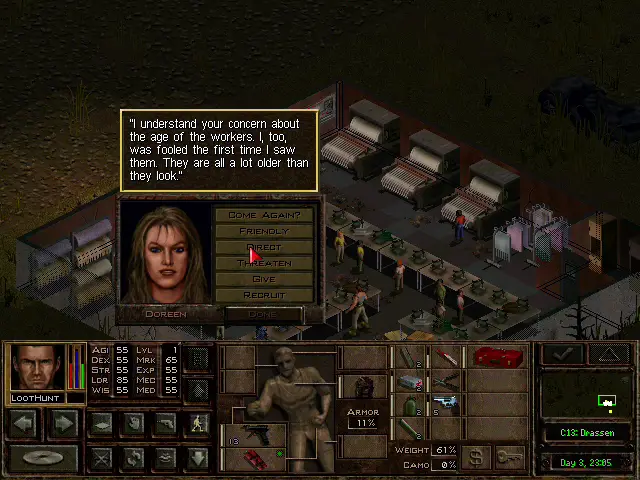
JA2 has quite a lot of role-playing for turn-based tactics. You can enter certain buildings sneakily or all-guns-blazing. You can give an artifact to its owner or to someone who will pay more. Kill or spare the lives of some characters. And sometimes a reaction to your merc’s requests depends on the “leadership” stat of that merc.
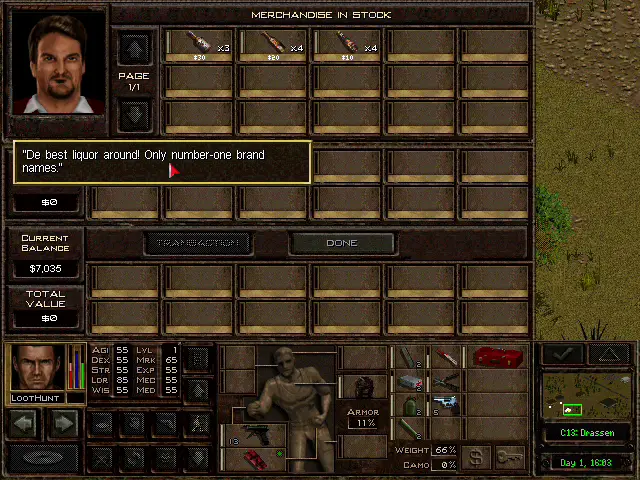
Mercenaries themselves are full-fleshed characters who in addition to attributes and skills also have a biography, sometimes connecting them to other mercenaries in the roster. Each has their own witty (or not quite) phrases while reacting to various events, complaining if you won’t allow to rest, or congratulating comrades with victory.
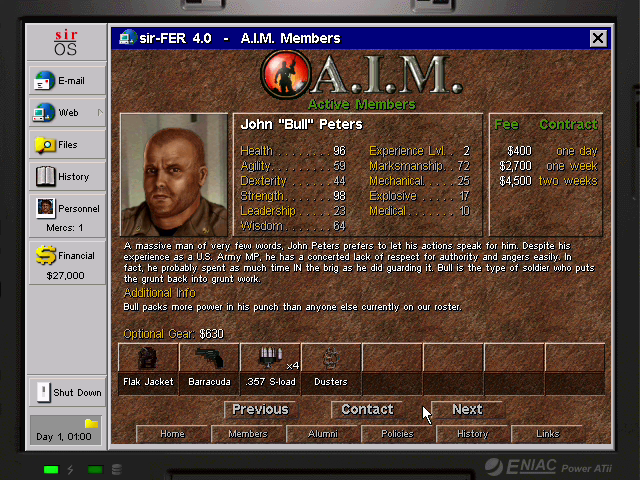
But mercs’ backstories are not just for the show. Their psychological profile affects their morale and thus performance. Nervous merc won’t be well alone. Aggressive ones will be happy to fight but upset if have to retreat, cowards are the opposite (and that’s actually good for making them scouts). Characters with claustrophobia have their morale down in the underground locations. Certain mercs don’t like each other and their morale decreases if they work in the same location. Others have a spirit boost if paired with someone they like. However, sometimes feelings aren’t mutual.
Strategic Layer
There are a lot more nuances that I’ve mentioned above. And that’s why it’s quite important to utilize the strategic layer of the game to the fullest. Group mercs into squads (each squad is six people max) according to their psychological compatibility. Make them rest and sleep when necessary.
You can also assign one merc to train others in a designated skill. Or to treat injuries – those who are injured should be designated as “patient” then. Or to repair equipment and vehicles.
Speaking of mercs. They are your main item of expenses – salary, equipment, even medical insurance (yes, you pay for that too, in case someone will be seriously injured at the end of their term). And if the contract ends with a mercenary having low morale, you’ll have to increase your payment to retain a dissatisfied guy (or gal). Sometimes, though, even that doesn’t help.
You also spend money on training militia, that repels Deidranna forces in your mercs’ absence. You can buy a Hammer vehicle for a merc squad to go faster. Or outright pay helicopter pilot to deliver said squad to anywhere in less than an hour. If you don’t stumble on SAM that is. Though SAM sites can be captured and neutralized… Oh, and don’t forget to pay for refuel cars and a helicopter.
The main source of income is a handful of mines that are located in some of the liberated towns. In addition to local workers bringing profit, you can also send mercs to find if there are some secret stashes underground. Then carry those and sell them.
Hardcore Much?
With all the nuances, my main problem is the game’s clunky interface. Case in point – one of the highlights in recent Phoenix Point was a direct visual depiction of shots trajectories, to contrast simple percent chance to hit in XCOM. But JA2 doesn’t have even that. No numbers at all! You literally have to guess the probability of your shot to connect and if additional aiming will be worth it.
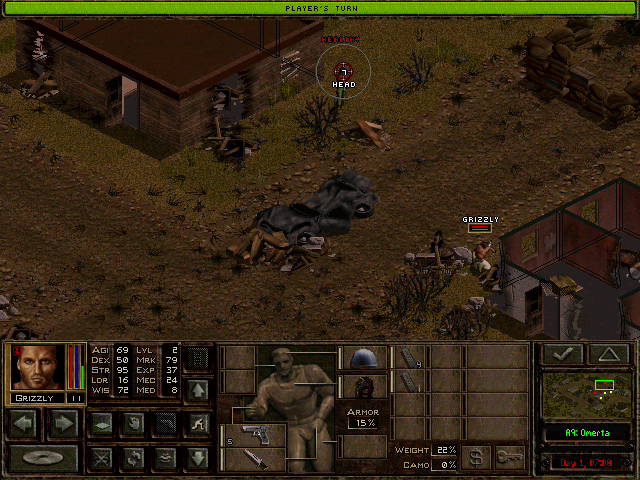
You also need to know a lot of stuff by heart. Like default AP cost for a shot, because current AP cost can be reduced if you fire at the same target from the same position. That’s actually neat nuance but I forgot about it and moved to get a better shot. And it turned out after the movement I didn’t have enough AP to shoot! Unlike Into the Breach, there are no ways to cancel movement or somehow check all the AP cost beforehand.
Managing mercs on the strategy layer isn’t much better. How long would it take to train militia? No way to predict, other than guess, considering leadership skill and settlement loyalty level. How long would it take for a wounded and tired merc to sleep or heal? Also in the realm of guessing. Well, at least they will tell you of being tired. Sometimes.
Old School Alliance
After playing JA2, I can easily see why it became a cult classic. And why so many attempts to “modernize” it failed.
There are so many tricks, nuances, and in-game mechanics! In 1999 people were amazed at all the opportunities the tactical and strategic layers of the game offered to them. And, obviously, making all those things not just work again, but also being bearable for a younger, less patient audience, is no small feat to achieve. It requires too much effort, especially for some companies that just would like to have a cheap and profitable remake.









